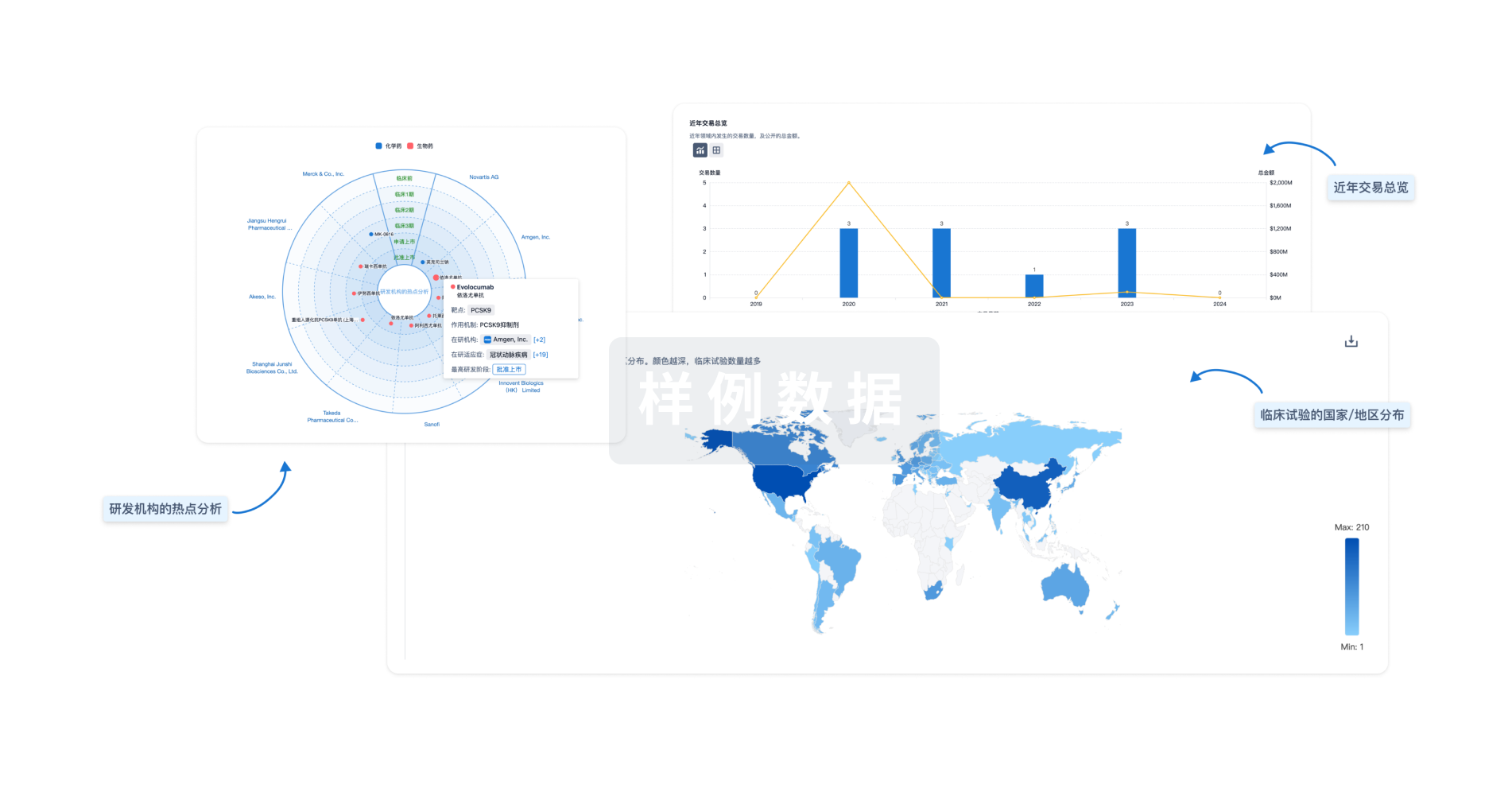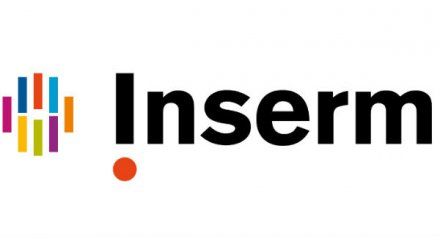预约演示
更新于:2025-05-07
SLC1A4
更新于:2025-05-07
基本信息
别名 alanine/serine/cysteine/threonine transporter、Alanine/serine/cysteine/threonine transporter 1、ASCT-1 + [6] |
简介 Sodium-dependent neutral amino-acid transporter that mediates transport of alanine, serine, cysteine, proline, hydroxyproline and threonine. |
关联
1
项与 SLC1A4 相关的药物WO2024121126
专利挖掘靶点 |
作用机制- |
在研适应症 |
非在研适应症- |
最高研发阶段药物发现 |
首次获批国家/地区- |
首次获批日期1800-01-20 |
100 项与 SLC1A4 相关的临床结果
登录后查看更多信息
100 项与 SLC1A4 相关的转化医学
登录后查看更多信息
0 项与 SLC1A4 相关的专利(医药)
登录后查看更多信息
205
项与 SLC1A4 相关的文献(医药)2025-06-01·Poultry Science
Transport and expression of transporters for 3-O-methyl-D-glucose and L-methionine along the intestine of broiler chickens receiving different methionine supplements
Article
作者: Schermuly, Isabel I ; Riedel, Julia ; Saliu, Eva-Maria ; Romanet, Stella ; Lemme, Andreas ; Zentek, Jürgen ; Aschenbach, Jörg R
2025-01-01·Analytical Cellular Pathology
SLC1A4 Promotes Malignant Transformation of Hepatocellular Carcinoma by Activating the AKT Signaling
Article
作者: Gong, Jian ; Zheng, Jiaoyun
2025-01-01·Cancer Medicine
Tandem Versus Single Autologous Stem Cell Transplantation for High‐Risk Multiple Myeloma in the Era of Novel Agents: A Real‐World Study of China
Article
作者: Dou, Xuelin ; Deng, Daoxing ; Lu, Jin ; Wen, Lei ; Wang, Fengrong ; Zhao, Peng ; Li, Jiangtao ; Ren, Juan ; Liu, Hui ; Huang, Xiaojun ; Wang, Liru ; Zhong, Yuping ; Mo, Xiaodong ; Peng, Nan ; Cao, Leqing ; Liu, Yang ; Chen, Yuan ; Bao, Li ; Liu, Xiaodan
1
项与 SLC1A4 相关的新闻(医药)2024-11-03
摘要:自然杀伤(NK)细胞是癌症免疫疗法的有力候选者,它们具有强大的先天细胞毒性,并且在嵌合抗原受体(CAR)治疗方面比T细胞具有独特优势。对病毒载体的安全性、成本和可扩展性的担忧激发了对非病毒基因传递替代品的研究。本综述全面分析了非病毒遗传修饰NK细胞在异体CAR-NK疗法中的最近进展和挑战。包括电穿孔和多功能纳米颗粒在内的非病毒替代品在CAR表达和转化反应方面受到检验。至关重要的是,NK细胞生物学与药物传递技术设计之间的联系被建立起来,这对于未来非病毒方法的发展至关重要。本综述为非病毒CAR-NK细胞工程的现状提供了宝贵的见解,旨在实现基于NK细胞的免疫疗法的全部潜力。
图形摘要:非病毒生产“现成的”CAR-NK细胞。
1.NK细胞可以从捐赠者血液中纯化,从干细胞分化,或在实验室中从永生化细胞系生产。
2.从CAR-T设计修改而来的NK特异性CAR设计,包括NK跨膜域(NKG2D、NKp44)、共刺激受体(例如,DAP10、2B4)和NK细胞受体(NKG2D)。
3.非病毒遗传修饰NK细胞可以包括通过DNA或mRNA传递CAR构建体,以及使用基因编辑工具(例如,CRISPR Cas9、转座子)敲入/敲出特定基因。这需要一种基因传递方法,可能包括电穿孔、脂质和多功能纳米颗粒和细胞。
1.引言
嵌合抗原受体(CAR)疗法是一种过继细胞疗法,其中T细胞、树突状细胞、巨噬细胞或自然杀伤(NK)细胞被遗传工程化以识别和消除癌细胞。CAR-T疗法是最成熟的形式,涉及修改患者的T细胞在体外表达一个CAR,该CAR能够识别癌细胞表面的肿瘤相关抗原(TAA),例如在许多B细胞淋巴瘤和白血病上表达的CD19。然后CAR-T细胞被扩增并重新输回患者体内,以靶向并杀死表达特定TAA抗原的肿瘤细胞。第一个CAR-T疗法于2017年获得美国食品药品监督管理局(FDA)的批准,到2022年又有五个产品获得批准;针对CD19+恶性肿瘤,包括白血病和淋巴瘤,或表达B细胞成熟抗原(BCMA)的多发性骨髓瘤(在表1中总结)。
基本CAR结构(图1)模仿T细胞受体激活,包括几个部分:一个识别癌细胞表面的特定抗原的细胞外域;一个对将信号发送到细胞内域至关重要的跨膜域,激活CAR-T细胞增殖和存活。CAR-T构建体设计已经经历了几代的发展,如图1所示。目前商业化的CAR-T细胞产品使用第二代CAR设计,增加了一个共刺激域(CD28或4-1BB)以增强T细胞增殖、持久性和细胞毒性(表1)。共刺激域的选择可以显著影响体内持久性;基于CD28的CAR T细胞持续约30天,而4-1BB CAR T细胞在某些患者中可能超过4年。
图1. CAR-T构建设计元素进展的详细示意图。第一代CAR由单链可变片段(scFv)抗原识别域、跨膜域和源自CD3ζ链(CD3ζ)的细胞内T细胞激活域组成,发展到第二代CAR设计,增加了额外的共刺激域(CD28或4-1BB),增强了T细胞的增殖和细胞毒性,被商业产品所采用。进一步的第三代CAR构建包含两个不同的共刺激域(例如,CD28和4-1BB)。“武装”的第四代CAR(也称为T细胞重定向用于通用细胞因子介导的杀伤(TRUCKs))包含可诱导表达的成分,如细胞因子(例如,IL-12),这可以增加CAR-T细胞的激活和肿瘤杀伤,第五代或称为“下一代”CAR包含一个截短的白细胞介素-2(IL-2)受体β链(IL-2Rβ),具有与转录因子STAT3的结合位点,以充分利用通过JAK-STAT3/5信号传导的CAR激活信号;增强T细胞的激活、增殖和持久性。此图使用BioRender.com创建。
血液系统恶性肿瘤,包括白血病、淋巴瘤和多发性骨髓瘤,迄今为止一直是CAR-T疗法的主要目标,治疗效果令人印象深刻。在2015年和2017年之间,针对tisagenlecleucel的第二阶段ELIANA临床试验,包括75名难治性或复发性B细胞急性淋巴细胞性白血病(ALL)的儿童患者,结果显示在三个月时的总体缓解率为81%。然而,73%的患者经历了严重的不良事件,其中47%发展为严重的细胞因子释放综合征(CRS)。CAR-T疗法的安全性问题是一个主要关注点,患者遭受的毒性包括CRS和肿瘤溶解综合征、神经毒性以及移植物抗宿主病(GVHD)的风险。此外,用CAR-T疗法治疗实体瘤已被证明更加困难,因为肿瘤异质性、炎症和肿瘤微环境中的免疫逃逸(TME)。与自体细胞疗法相关的成本也极高,CAR-T疗法的治疗费用从373,000美元到475,000美元不等,还有与白细胞分离、淋巴细胞清除疗法以及CAR-T免疫疗法的副作用相关的额外成本。例如,使用tisagenlecleucel治疗的患者的总治疗费用据报道,对于没有CRS的患者范围从478,777美元到对于有严重CRS的患者531,823美元,由于需要进一步的治疗和医院护理,包括在某些情况下的重症监护治疗。因此,有必要开发更安全的替代品,以减少患者的并发症风险,同时也有助于降低制造成本和与医院治疗相关的成本,以管理严重的副作用。这样的替代品之一是使用自然杀伤(NK)细胞进行CAR疗法,它们有潜力克服CAR-T疗法中的一些问题。
2.自然杀伤(NK)细胞
NK细胞是高度细胞毒性的免疫效应器,被定义为CD56+ CD3–淋巴细胞,能够发挥自然细胞毒性和抗体依赖性细胞毒性(ADCC)。它们在癌症监测中扮演重要角色,具有对癌细胞的自发细胞毒性的独特能力,无需事先暴露或由其他免疫细胞刺激,这归功于一系列激活受体。NK细胞可以通过下调通常在健康细胞上表达的人类白细胞抗原(HLA),与主要组织相容性复合体(MHC)同义,或上调应激诱导配体,如主要组织相容性复合体类1链相关蛋白A和B(MICA, MICB)来识别异常细胞。在识别目标细胞后,NK细胞通过涉及多种受体、共受体和细胞内蛋白的复杂信号传导途径被激活,包括自然细胞毒性受体(NCRs)、杀伤Ig样受体(KIRs)、NKG2D和DNAM-1。许多NK激活和抑制受体协同作用,提供一种自我调节机制,以防止对健康细胞的损害,如图2总结,更详细的内容在表2中。
图2. NK细胞常见的激活性A和抑制性B受体及其相应配体的简化示意图。NK受体协同作用,提供一种自我调节机制,以防止对健康细胞造成损害,并且可能通过下调人类白细胞抗原(HLA,与主要组织相容性复合体MHC同义)或上调应激诱导配体(如主要组织相容性复合体类1链相关蛋白A和B,MICA,MICB)来识别异常细胞。在识别靶细胞后,NK细胞通过涉及多种受体、共受体和细胞内蛋白的复杂信号传导途径被激活,包括自然细胞毒性受体(NCRs)、杀伤细胞免疫球蛋白样受体(KIRs)、NKG2D和DNAM-1。此图使用BioRender.com创建。
抑制性受体识别HLA分子,使自然杀伤(NK)细胞能够区分正常细胞和异常细胞。当激活受体的平衡倾向于激活时,会释放含有穿孔素和颗粒酶B的细胞毒性颗粒,通过caspase介导的凋亡直接杀死目标细胞。NK细胞还表达死亡受体,如FasL、TRAIL和肿瘤坏死因子-α(TNF-α)受体,以诱导表达相应受体的目标细胞凋亡。产生多种细胞因子和趋化因子,如干扰素-γ(IFN-γ)和TNF-α,激活其他免疫细胞,包括树突状细胞、巨噬细胞和T细胞,并促进炎症。此外,NK细胞能够通过识别被抗体包被的目标细胞进行抗体依赖性细胞介导的细胞毒性(ADCC)。成熟的NK细胞表达CD16受体(也称为FcγRIIIA),该受体识别与目标细胞表面表位结合的免疫球蛋白G(IgG)的Fc片段。与IgG包被的细胞相互作用后,含有免疫受体酪氨酸基激活基序(ITAM)的CD16亚基将受体连接到细胞内信号传导途径,触发肌动蛋白和微管的重组以实现ADCC。这最终导致含有穿孔素和颗粒酶的细胞毒性颗粒的释放,FasL和TRAIL死亡受体的参与,以及促进进一步招募多种免疫细胞的细胞因子和趋化因子的释放。CD16的表达对于NK细胞的ADCC功能至关重要,并且表达在更成熟的NK细胞上。因此,CD16的表达在命名法中用于分类NK细胞的成熟状态。人类NK细胞通常被细分为两个主要亚群:CD56brightCD16dim/−和更成熟的CD56dimCD16+。CD56dim亚群在外围血液中更为常见,而CD56bright在组织中更丰富。CD56bright NK细胞被认为是不成熟的,表达NKG2A但不表达KIRs。它们的细胞溶解能力差,分泌细胞因子IFN-γ、GM-CSF,并对IL-2或IL-15产生反应而增殖。相反,CD56dim被认为是成熟的,表达NKG2A和/或KIR受体,并在激活时具有强大的细胞溶解活性和细胞因子分泌能力。最成熟的、终末分化的NK细胞被分类为CD56dim KIRpos CD57pos CD16bright(图3)。成熟的CD56dimCD16+亚群是癌症治疗的理想选择,因为它们具有强大的细胞溶解活性和ADCC能力。因此,采用NK细胞的过继免疫疗法已成为一种有希望的治疗选择,研究正集中在探索如何利用NK细胞的力量用于癌症免疫疗法,如CAR-NK细胞疗法。[图3]。
图3. NK细胞成熟度与其他免疫细胞的相互作用。A. NK细胞根据成熟状态改变受体状态,从未成熟的CD56bright/CD16−细胞到成熟的CD56dim/CD16+细胞,以及最终分化的NK细胞,这些细胞有时也被称为“记忆样”NK细胞。B. NK细胞在激活后与髓系细胞和靶细胞的信号传递和相互作用。NK细胞通过直接杀伤(激活受体包括NKG2D、NKp30、NKp44、NKp46、KIRs)、凋亡(TRAIL和FasL死亡受体)和/或ADCC(CD16)对靶细胞发挥细胞毒性,并产生炎症细胞因子和趋化因子,这些因子刺激并招募其他免疫细胞。此图使用BioRender.com创建。
2.1.CAR-NK疗法的优势
与T细胞相比,NK细胞在CAR疗法中具有几个潜在优势,包括增强的安全档案、异体疗法的潜力以及通过CAR依赖和非CAR依赖的癌细胞靶向实现更广泛的目标特异性。CAR-Ts分泌包括IL-1、IL-2、IL6、TNF-α、MCP1、IL8、IL10、IL-15在内的一系列细胞因子。这些细胞因子,特别是促炎性的TNF-α、IL-1和IL-6,被报道是与CAR-T疗法相关的严重副作用的原因,包括神经毒性和CRS。相比之下,CAR-NK与不同的细胞因子档案相关,它分泌IFN-γ和GM-CSF。事实上,在给药CD19+淋巴样肿瘤患者后,CAR-NK细胞的炎症细胞因子并未超过基线。这种细胞因子释放档案的差异被认为是NK细胞增强安全档案的原因之一,导致毒性较小,减少细胞因子风暴的发生。尽管重要的是要注意这些结论是基于有限数量的临床CAR-NK研究和有限的患者数量,与许多大型CAR-T临床研究相比,并且尚未在CAR-T和CAR-NK疗法之间进行直接比较。CAR-NK细胞的另一个潜在安全优势是降低了与CAR-T细胞相关的靶向内肿瘤毒性的风险。所有细胞,无论是恶性还是非恶性的,如表达CAR靶抗原的CD19+ B细胞,都可能被CAR-T细胞靶向。NK细胞上的抑制性受体可能在非恶性细胞被CAR抗原识别时充当安全开关。如果识别非恶性细胞,将启动NK抑制信号,防止靶向内肿瘤毒性。
NK细胞在异体应用中的潜力在于CAR-NK细胞治疗后GVHD(移植物抗宿主病)的低风险。在T细胞的情况下,由于它们的αβ T细胞受体(TCRs)高度多变,供体T细胞与受体组织细胞广泛表达的HLA I类分子结合。在供体T细胞输注后,TCR识别HLA为外来物,启动针对受体细胞的免疫反应,导致导致GVHD的异体反应。相比之下,NK细胞的活性不依赖于HLA I类识别,允许NK细胞针对经常丢失HLA I类受体作为免疫逃逸手段的恶性细胞。因此,NK细胞治疗的GVHD风险较低,并且NK细胞的研究在安全性方面取得了有希望的结果。
由于安全性档案的改善和GVHD风险较低,有可能开发出一种“现成的”CAR-NK产品,这可能对领域产生变革性影响。尽管正在研究自体NK细胞治疗,但异体NK细胞可能比自体NK治疗更有效,克服了来自免疫抑制患者的耗尽NK细胞的问题。异体供体NK细胞可以大规模培养,便于更有效的质量控制测试、转染和输注;允许从同一批次治疗多名患者,这可能消除了对专业中心的需求。相比之下,目前CAR治疗中使用的T细胞通常来源于患者自身的细胞,这可能既耗时又昂贵,并且难以收获和工程化。自体CAR-T治疗的费用可能高达每次治疗475,000美元,由于CAR-T治疗劳动密集、难以扩展且容易失败。相比之下,一个周期的异体“现成的”NK-92治疗的费用可能不到20,000美元,使其成为一个更具成本效益的选择。需要注意的是,只有在多个患者之间共享工程化的异体NK细胞产品时,才能实现这样的成本节省。此外,生产异体T细胞的努力也在进行中,也可能有助于克服自体T细胞工程化过程中遇到的问题。
CAR-NK疗法可能在实体瘤治疗中具有潜力。CAR-T疗法在实体瘤中产生了令人失望的治疗结果,原因是诸如肿瘤异质性、免疫抑制性肿瘤微环境(TME)、不足的交通和渗透以及毒性等障碍。CAR-NK细胞已在多种实体瘤中进行了研究,如胶质母细胞瘤、小细胞肺癌、乳腺癌、前列腺癌、卵巢癌、结直肠癌和胰腺癌,并且提出NK细胞的天然属性可能对治疗实体癌有益。与稳定过表达B细胞抗原的淋巴瘤相比,实体瘤通常具有可变的抗原表面表达水平和肿瘤内及原发与转移组织之间的异质性,使得用单一CAR目标成功治疗变得困难。除了任何CAR修饰外,NK细胞还有潜力通过多个激活和抑制受体识别异质性肿瘤细胞,尽管HLA-I分子的表达减少或缺失。激活信号的存在,如NKG2D,允许NK细胞直接对缺乏特定CAR抗原并可能被CAR-T细胞遗漏的转化细胞发挥其细胞毒性,这在异质性实体瘤环境中很常见。这是NK细胞相对于CAR-T细胞的一个明显优势,后者只对表达CAR抗原的细胞活跃,并允许NK细胞针对更广泛的癌细胞群体。实际上,即使没有CAR抗原的添加,未修饰的NK细胞已被用于针对癌细胞,并已在临床试验中显示出其有效性的早期迹象。此外,除了它们对癌细胞的直接细胞毒性效应外,NK细胞对于招募常规1型树突状细胞(cDC1)和随后的CD8+ T细胞也很重要,这将促进癌症免疫周期的激活,有潜力克服免疫抑制性TME。
3.CAR-NK 疗法的发展现状
目前市场上还没有获批的基于 NK 细胞的产品,但自 2016 年以来,研究 NK 细胞疗法的临床试验数量激增,截至 2023 年 5 月,已有近 60 项试验启动。该领域仍处于新兴阶段,大多数试验处于 I 期或 II 期,并且仍在进行中,因此结果尚未完全报告。然而,早期数据令人鼓舞,表明 CAR-NK 细胞疗法是安全的,并有潜力成为癌症的有效治疗方法,尽管尚未报告显著的临床效果。虽然针对多种抗原和恶性肿瘤,但相当数量的 CAR-NK 试验集中在针对 CD19 的血液癌症,这是 CAR-T 疗法成功的目标之一。一个针对 CD19 的 CAR-NK 细胞的例子是,一项 I/II 期临床试验,研究 CD19 靶向 CAR-NK 细胞在复发或难治性 CD19+ B 淋巴样恶性肿瘤患者中的安全性和有效性,包括急性淋巴细胞性白血病(ALL)、慢性淋巴细胞性白血病(CLL)和非霍奇金淋巴瘤(NCT03056339)。来源于脐带血的 HLA 不匹配 NK 细胞与 K562 饲养细胞共培养,并与 IL-2 一起在第 6 天通过逆转录病毒载体转导,表达抗 CD19 CAR、IL-15 以增强 CAR-NK 细胞在体内的扩增和持久性,以及诱导性 Cas9 作为安全开关,在不可接受的毒性效应情况下触发 CAR-NK 细胞的凋亡。扩增后,CAR-NK 细胞在第 15 天收获用于新鲜输注,并给与 37 名复发或难治性 CD19+ 癌症患者,包括非霍奇金淋巴瘤和 CLL。临床对疗法的反应基于 2018 年慢性淋巴细胞性白血病国际研讨会(iwCLL)的标准和 2014 年非霍奇金淋巴瘤的卢加诺分类。1 年总生存率为 68%,无进展生存率报告为 32%。重要的是,没有发生显著毒性,包括 CRS、神经毒性或 GVHD,炎症细胞因子水平也没有增加,包括 IL-6。这一有希望的临床结果和安全概况突出了 CAR-NK 疗法作为异体疗法的潜力,可以开发成“现成”产品。CAR-NK 细胞疗法治疗实体瘤的潜力推动了这一领域的研究,目前正在进行的几项临床试验涉及胶质母细胞瘤、小细胞肺癌、乳腺癌、前列腺癌、卵巢癌、结直肠癌和胰腺癌。这些研究中的许多还处于非常早期阶段,仍在招募患者,因此结果尚未完全报告。最近,Burger 等人发表了第一项探索胶质母细胞瘤患者中 CAR-NK 细胞疗法的临床试验结果;一项 I 期试验,研究在复发手术期间颅内注射针对人表皮生长因子受体 2(HER2)的 CAR-NK 细胞在 9 名复发 HER2+ 胶质母细胞瘤患者中的疗效(NCT03383978)。这项研究调查了慢病毒转导的 NK-92 细胞表达 CAR,包括 HER2 特异性单链抗体、CD8α 铰链区和 CD28 及 CD3ζ 信号域。在手术期间将 CAR-NK 细胞注入手术腔边缘后,五名患者的病情稳定,持续了 7 至 37 周。四名患者病情进展,两名患者在注射部位出现假性进展,提示治疗诱导的免疫反应。对于所有患者,中位无进展生存期为 7 周,中位总生存期为 31 周。此外,没有剂量限制毒性,也没有患者发展为 CRS 或免疫效应细胞相关神经毒性综合征。这项研究表明 CAR-NK 细胞治疗胶质母细胞瘤的可行性和安全性。尽管这是一项非常侵入性的研究,需要在手术期间注射 CAR-NK 细胞,但需要进一步研究以评估 CAR-NK 细胞通过静脉输注靶向和渗透实体瘤的能力。希望这些有希望的结果也能在其他实体瘤类型中复制,早期阶段的临床试验正在进行中。
4.CAR-NK 生产考虑因素
尽管安全性和治疗结果令人鼓舞,但 CAR-NK 疗法仍处于起步阶段,在它们被批准用于临床之前还有很多工作要做。如果需要实现 CAR-NK 疗法的潜力,需要解决的一些考虑因素包括 NK 细胞的来源、CAR 结构设计以及 NK 细胞的遗传修饰方法。
4.1.异体 NK 细胞来源
异体 NK 细胞可从多种来源获得,包括外周血(PB)、脐带血(CB)、诱导多能干细胞(iPSCs)和永生化细胞系。这些来源在扩增和遗传修饰方面都有其独特的考虑因素,目前都在临床研究中。
从外周血(PB)和脐带血(CB)衍生的 NK 细胞
从 PB 或 CB 来源的 NK 细胞是获取 CAR 疗法 NK 细胞的主要方法,广泛用于 NK 细胞应用。然而,细胞增殖能力可能较低,细胞存活时间短。大约 85-95% 的 PB NK 细胞是 CD56dimCD16high,具有高度的细胞毒性,但与其产生细胞因子的 CD56bright 对应物(占 PB NK 的 5-15%)相比,增殖能力较低。相比之下,由于常规储存,CB 衍生的 NK 细胞可能更容易获得,并且比 PB NK 细胞更具增殖性,允许在体外轻松扩增。然而,CB NK 细胞在表型和功能上不成熟,可能不如其他来源的 NK 细胞具有细胞毒性。从 PB 或 CB 分离 NK 细胞后,需要扩增以创建异体剂量,由于治疗剂量所需的 NK 细胞数量大,这已被证明是具有挑战性的。扩增协议可分为基于饲养细胞的或无饲养细胞的系统。与饲养细胞(例如 Epstein-Barr 病毒转化的淋巴母细胞系(EBV-LCL))共培养,这些细胞向 NK 细胞呈现配体,刺激 NK 细胞的激活和扩增,相对快速地扩增到大量(几周内)。然而,使用饲养细胞与安全和监管问题相关,包括最终 NK 细胞产品中残留活性饲养细胞的潜力。因此,已开发了使用细胞因子和抗体刺激 NK 细胞的无饲养细胞扩增方法。包括 IL-2 和 IL-15 在内的细胞因子是强大的 NK 细胞刺激剂,但包括 IL-15、IL-21、IL-12、IL-18 和 IL-27 在内的一系列细胞因子组合已显示出扩增 NK 细胞的前景。虽然无饲养细胞系统避免了与饲养细胞相关的安全问题,但产生的 NK 细胞产量较低。将饲养细胞遗传修饰以表达刺激细胞因子的组合已产生高度细胞毒性和增殖性的 NK 细胞。例如,K562 饲养细胞遗传修饰以表达膜结合 IL-15 和 41BB 配体(K562mbIL12-41BBL)在培养 10 天内导致大量扩增 PB NK 细胞在透气静态细胞培养袋(G-REX)中。另一个可能影响 NK 细胞效力的因素是冷冻保存。从 PB 或 CB 来源的 NK 细胞可能在扩增前或在“现成”产品的情况下需要冷冻保存,这可能对 NK 细胞的增殖和细胞毒性功能产生不利影响。潜在的解决方案包括准备额外的细胞以弥补冷冻保存后的损失,或在解冻后立即用 IL-2 等细胞因子刺激,或用 IL-15 和 IL-18 预处理以提高冷冻保存后的活性。此外,在非病毒遗传工程方法的背景下,与 iPSCs 和细胞系相比,PB 和 CB NK 细胞仍然难以操纵。与 NK 细胞的培养和扩增相关的因素可能影响转染率,包括 NK 细胞的激活状态、扩增期间的转染时机、扩增方法(饲养或无饲养方法)和冷冻保存。病毒转导率在体外扩增(激活)的 NK 细胞中得到增强,而在静止的原代 NK 细胞中观察到较低的转导。大规模扩增 NK 细胞的标准协议需要在病毒转导前的初始扩增,然后是第二阶段的扩增。这种顺序的原代扩增、遗传编辑和次级扩增协议也适用于电穿孔,基于饲养细胞或无饲养系统的扩增方法和时机也可能影响转染率。饲养细胞可能通过诱导细胞分裂增强遗传编辑,饲养刺激可能支持 NK 细胞在体外操纵后的恢复。例如,Pomeroy 等人观察到在与 K562-mbIL-21-41BB 饲养细胞共培养的 PB NK 细胞电穿孔后第 4 天 TcBuster 的转位最高。根据协议阶段调整饲养细胞与 NK 细胞的比例(电穿孔前 2:1 饲养:NK,电穿孔后 48 小时 5:1 或所有随后扩增的 1:1)。同样,Gurney 等人使用 EBV-LCL(10:1 饲养:NK 比例)在 IL-2 和 IL-21 存在下激活 NK 细胞。NK 细胞在第 4 天电穿孔并在 IL-15 存在下休息 48 小时,然后重新刺激饲养细胞。进一步扩增进行到第 25 天,观察到不同捐赠者之间细胞扩增的变化。这突出了遗传工程和扩增 NK 细胞所需的优化的复杂性,并且一系列因素可能影响转导/转染率,尚未建立标准协议。需要进一步的研究来阐明最佳条件,并且可能需要根据基因传递方法定制条件。
iPSC 衍生的 NK 细胞
作为解决原始 PB 和 CB 衍生 NK 细胞问题的替代方案,iPSC 提供了无限的资源来生产同质 NK 细胞,并且可以在大规模上进行遗传修饰和扩增。从单一 iPSC 系生成的 iPSC 衍生 CAR-NK 细胞,然后进行分化和扩增,成为通用的细胞产品,有潜力成为“现成”疗法。2021年12月,Fate Therapeutics 的新闻稿详细介绍了一项 I 期研究的中期临床数据,该研究调查了表达 CD19 的“现成” iPSC 衍生 CAR-NK 细胞(称为 FT596),用于治疗复发/难治性 B 细胞淋巴瘤(NCT04245722)。FT596 iPSC CAR-NK 细胞被设计表达高亲和力不可切割的 CD16 变体,以增强 ADCC;一种膜结合 IL-15/IL-15R 融合蛋白,以支持体内持久性;以及针对 NK 细胞优化的抗 CD19 CAR,用于直接肿瘤靶向。据报道,接受第二个 FT596 周期治疗的 11 名患者中有 10 名持续反应,其中三名患者在≥6 个月的随访中持续完全反应。此外,FT596 治疗方案耐受性良好,没有剂量限制毒性,如神经毒性或 GVHD,尽管在 FT596 单剂量递增队列中有两例低级别不良事件的 CRS 报告,这些事件在未经重症监护治疗的情况下得到解决。这些早期数据突出了 iPSC CAR-NK 疗法的潜力,但在这种疗法在临床上更大规模推广之前,需要完成进一步的研究和优化。iPSC NK 细胞的一个问题是需要高度专业化的培养条件,其中 iPSC 被分化为 CD34+ 造血祖细胞,然后进一步分化为 NK 细胞。从 iPSC 生产 NK 细胞的成熟协议可能需要 4-5 个月,尽管最近开发了一种新方法,将处理时间缩短到大约 2 个月。控制 iPSC 的分化是一个劳动密集型的制造过程,需要遗传工程和细胞培养专业知识,这对于大规模生产财务上可行且能够被更广泛患者群体接受的“现成”产品可能是有问题的。此外,存在对 iPSC 遗传突变风险的主要关注,特别是当需要长时间的培养时。此外,还存在未分化 iPSC 潜在的肿瘤形成风险。因此,需要开发稳健的质量测试对 iPSC 衍生的细胞进行筛选,包括筛选在培养过程中可能发生的任何遗传改变。
NK 细胞系
迄今为止,已有 10 个永生化模型 NK 细胞系,包括 NK-92、KHYG-1、NKL 和 YT,它们是从 NK/T 淋巴瘤患者中建立的,并用于 CAR 疗法的临床前开发。NK 细胞系对恶性细胞具有高度的细胞毒性,并且比原始 PB 或 CB 来源的 NK 细胞更容易进行遗传修饰和扩增。尽管需要注意的是,与其他类型的细胞系相比,NK 细胞系更难培养,因为它们对培养条件的变化非常敏感,通常需要添加细胞因子 IL-2 或 IL-15 来支持增殖。由于 NK 细胞系的恶性特性,因此在转移给患者之前需要进行辐射处理,这可能对输注的 NK 细胞的存活和细胞毒性效应产生不利影响。尽管如此,NK-92 细胞已获得 FDA 批准用于临床使用,到 2021 年,它们是临床试验中最常用的工程化 NK 疗法来源(占试验的 43%),其次是 PB NK(21%)、iPSC(17%)和 CB NK(13%)。NK-92 细胞系源自 1994 年一名 50 岁男性非霍奇金淋巴瘤患者,由于表达 CD56 和许多主要 NK 激活受体,包括 NKp30、NKp46、2B4、NKG2D 和 CD28,被认为是类似 NK 的细胞系。相反,NK-92 细胞几乎缺乏所有的 KIR 受体,并且表达很少的抑制性受体(NKGA/B、低水平的 KIR2DL4、ILT-2),并且不表达负责 ADCC 的 CD16 受体。NK-92 细胞的强细胞毒性可以归因于这种受体表达谱,当激活时,它触发穿孔素-颗粒酶细胞毒性途径,以及由 FasL、TRAIL、肿瘤坏死因子样弱诱导凋亡因子(TWEAK)和 TNF-α 引导的死亡受体细胞毒性途径。为了克服 NK-92 细胞的局限性并朝着开发“现成” CAR-NK 细胞的方向迈进,已经开发了几个衍生细胞系。NK-92MI 被设计为产生 IL-2,从而不需要补充 IL-2。首个人体临床试验(NCT02944162)中,NK-92MI 表达 CD33 CAR 用于治疗复发和难治性急性髓系白血病(AML)患者,证明了这些细胞的临床安全谱。NK-92MI 细胞被慢病毒转导 CAR CD33.CD28.41BB.CD3z 构建体,扩增并在输注前共辐射(10 Gy)。在每个患者输注高达 5×10^9 个细胞后,未观察到显著的不良效应,尽管一名患者经历了 I 级 CRS。接受治疗的三名患者中,一名患者对治疗没有反应,而另外两名患者在 1 个月和 4 个月后复发。尽管这是一项小规模研究,患者数量有限,但它有助于证明 CAR-MI 细胞的积极安全谱,但治疗效果并不令人印象深刻。
NK-92细胞系的进一步优化产生了高亲和力NK-92(haNKs),这些细胞表达CD16受体,增加了抗体依赖性细胞介导的细胞毒性(ADCC)活性。目标亲和力NK-92(taNK)经过改造,能够针对特定的肿瘤细胞配体,此外,t-haNKs结合了所有这些特性,表达高亲和力CD16,分泌IL-2,并识别特定的肿瘤配体,如PD-L1。在II期QUILT 88试验(NCT04390399)之后,t-haNKs治疗典型难以治疗的胰腺癌的潜力得到了突出,该试验调查了ImmunityBio的Nant癌症疫苗,包括PD-L1靶向t-haNK细胞与IL-15受体激动剂Anktiva(N-803)、阿霉素、白蛋白修饰剂以及低剂量化疗在胰腺癌治疗中的组合。在联合治疗后,第三、第四和第五线患者的总生存期为5.8个月,几乎是历史生存期3个月的两倍,严重副作用不常见,为8%。随着许多关于CAR表达NK-92细胞的试验正在进行,调查使用包括CD19、MUC-1、HER2、ROBO1和PD-L1在内的一系列癌症靶标治疗血液和实体肿瘤,这些早期积极的结果可能预示着利用NK-92细胞的CAR-NK疗法的未来潜力。
KHYG-1细胞系已被证明比NK-92细胞具有更强的细胞毒性。这表明这个细胞系也可以作为“现成的”CAR-NK疗法的治疗应用,如Stikvoort等人的概念验证研究中所报告的。KHYG-1细胞通过逆转录病毒转导了含有CD28共刺激域的CD38-CAR,并产生了针对CD38high多发性骨髓瘤(MM)细胞系(UM9和THP-1)和来自患者的原发性MM细胞的有效CD38依赖性细胞毒性。此外,CD38-CAR KHYG-1细胞显著减缓了UM9肿瘤在具有人骨髓样生态位的RAG2–/–γc–/–小鼠异种移植模型中的生长。植入了表达荧光素酶的UM9 MM肿瘤的RAG2–/–γc–/–小鼠接受了多次静脉注射CD38-CAR KHYG-1细胞的治疗,治疗后20天,与未经治疗的对照组的24倍增长相比,CD38-CAR KHYG-1治疗小鼠的生物发光仅增加了四倍。这项研究突出了KHYG-1细胞被开发成类似于NK-92细胞的CAR-NK细胞的潜力,但需要进一步的研究来评估这在人类中的潜力,因为小鼠模型中的结果并不总是能够转化为人类。
从恶性来源衍生的NK细胞系在临床应用前需要进行辐射,这可能会影响其在体内的增殖和持久性。例如,NK-92细胞在体内的寿命很短,通常在初次输注后两天,这在减少副作用方面可能是有利的,与可以循环数月或数年的CAR-T疗法相比。然而,这种短暂的寿命可能导致较差的治疗结果和多次治疗的需求。已经对NK-92细胞进行了工程改造,以表达IL-2,增强体内扩增,但需要更复杂的工程来对抗TME中的NK耗竭,特别是对于实体肿瘤的治疗。KHYG-1细胞强烈表达抑制性受体NKG2A,当与MM细胞共培养时,发现其表达高水平的PD-1。这可能是CAR-NK疗法发展的一个主要障碍,需要在这些疗法成功之前加以解决。
4.2.NK细胞的CAR构建设计
最初的CAR-NK研究采用了旨在模仿T细胞受体的CAR-T骨干。然而,NK细胞毒性是由一组不同的激活和抑制受体调节的,这些受体可以并入CAR设计中,以激活天然NK受体并利用NK功能。CAR-NK细胞可以通过表达包含NK特异性跨膜信号域以及共刺激受体(例如,NKG2D、DNAM-1、2B4、CD28或4-1BB)的抗原特异性CAR分子来工程化,以优化NK细胞效应功能。这些设计旨在增强NK细胞在识别肿瘤抗原时的激活,并提高CAR-NK细胞的持久性、细胞毒性和细胞因子产生能力(图4)。
图4. 比较CAR-T和CAR-NK疗法中CAR构建设计元素的示意图。最初研究CAR-NK细胞时使用的构建与第三代CAR-T疗法中使用的构建相同,这些构建旨在模仿T细胞受体。此后,已开发出针对NK细胞的特定CAR构建,以纳入NK跨膜信号域以及共刺激受体(例如,DAP10、2B4、CD28或4-1BB),以增强NK细胞的效应功能。激活受体NKG2D也被纳入NK特异性CAR构建中;尽管NKG2D不是经典的“CAR”因为它不是单链可变片段(scFv),但在文献中它们被称为CAR。此图使用BioRender.com创建。
Li等人筛选了几种为NK细胞活动优化的CAR构建,包括各种跨膜和共刺激域的组合。比较了表达针对间皮素的CAR的iPSC-NK细胞(称为CAR-iPSC-NK),该CAR包含NKG2D跨膜域、2B4共刺激域和CD3ζ信号域,与基于T细胞的CAR包含两个CD28域与4-1BB(CD137)和CD3ζ(称为T-CAR-NK)在荧光素酶表达的A1847卵巢癌异种移植模型中的活性。与T-CAR-NK治疗组相比,CAR-iPSC-NK在生物发光成像后导致肿瘤负担显著减少并改善了生存期。此外,在与表达CAR的原代T细胞进行比较后,CAR-iPSC-NK组在70天时的生存期提高到80%,而T-CAR组为20%。重要的是,T-CAR组表现出严重副作用的证据,包括显著的体重减轻(>50%,在第23天和第39天各有2个n),严重的内脏出血和缺血,脾脏肿大以及对包括肝脏、肺、肾脏和肠道在内的内部器官的病理性损害的证据。相比之下,CAR-iPSC-NK治疗组没有观察到这样的效果。
我们知道NKG2D是一个主要的激活受体,负责在识别肿瘤细胞上表达的“杀伤我”压力信号,即MICA、MICB和UL16结合蛋白(ULBP-1和ULBP-6)后,引发caspase介导的凋亡。利用NKG2D可以增强NK细胞的抗肿瘤细胞毒性。Xiao等人报告了一项小型临床试验,研究PBMC衍生的NK细胞表达NKG2D与DAP12共刺激域融合,通过腹腔内(i.p.)输注给三名转移性结直肠癌患者(NCT03415100)。作者报告说,在两名患者中,腹水生成减少,腹水中的肿瘤细胞显著减少,而在第三名患者中,通过超声观察到肝脏区域的肿瘤迅速退缩,并通过PET-CT扫描确认完全的代谢反应。所有三名患者均报告病情稳定,重要的是,没有观察到剂量限制性毒性或GVHD。尽管这项研究中使用的CAR构建只有一种细胞内域的第一代设计,但它为进一步开发携带NKG2D受体的下一代CAR构建铺平了道路。这强调了精心设计的NK特异性CAR构建的重要性,以最大化CAR-NK治疗效应并减少与CAR-T构建相比的副作用,仍有相当数量的NK受体、共刺激域和每种组合需要探索。
4.3.CAR-NK制造的遗传改造方法
对于大规模生产“现成的”CAR-NK产品,用于遗传工程NK细胞的方法是一个重要的考虑因素,这可能影响生产时间、成本和可扩展性。理想情况下,用于创建CAR的转染方法应该是高效的、可扩展的,且非免疫原性的。目前,大多数CAR疗法是使用病毒载体工程化的,与非病毒方法相比,病毒载体产生稳定的基因表达和更高的转导率。NK细胞极难转导,特别是原发性PB和CB NK细胞,即使使用通常非常有效地转导广泛细胞的病毒载体;由于高表达免疫受体,如模式识别受体(PRRs),这些受体在病毒转导后触发NK细胞的凋亡。因此,通常用于CAR-T生产的遗传编辑的病毒载体,如水泡性口炎病毒G蛋白(VSV-G)慢病毒,在NK细胞中的转导率降低(<10%转导效率)。在VSV-G的情况下,这据说是由于NK细胞上低密度脂蛋白受体的低表达,这是VSV-G细胞进入所需的。
狒狒包膜假型慢病毒载体(BaEV-LV),它结合钠依赖性中性氨基酸转运蛋白(ASCT1和ASCT2)进行细胞进入,已被报道在新鲜分离的人NK细胞中产生23%的增强转导,并至少持续21天的稳定转基因表达。对于体外遗传工程,慢病毒载体的稳定表达是一个重要考虑因素,因为细胞被工程化以永久表达转基因,然后扩增后再输注给患者。然而,病毒载体有显著的缺点,包括关于突变、毒性、免疫原性的安全问题;昂贵且耗时的生产,除此之外还有漫长的NK细胞扩增协议;以及有限的核酸载体能力,这在传递更大的第三代、第四代和第五代CAR构建时可能是有问题的。例如,用于慢病毒生产的第二代CAR构建可能在10 kbp左右,随着后续几代中添加更多组件,这个数字会增加到20 kbp。因此,需要开发更安全、更高效的非病毒遗传改造方法用于CAR-NK生产。
5.基因编辑工具用于CAR-NK细胞
遗传编辑工具的发展,如DNA转座子和规律成簇短回文重复序列(CRISPR)技术,提供了一种稳定的转基因表达的非病毒方法。转座子系统是一类具有从一个位置移动或“转座”到基因组内另一个位置能力的遗传元素,通过“剪切和粘贴”机制,使它们成为遗传工程的强大工具。最有希望用于基因治疗的转座子是源自睡美人(SB)和猪儿虫(PB)系统。转座子系统由两个组成部分构成,转座子包含感兴趣的基因,通常以质粒形式存在,以及相应的转座酶酶,可能以蛋白质或编码转座酶蛋白的mRNA形式存在。转座子由特定的DNA序列包围,称为反向末端重复序列(ITRs),被转座酶识别。一旦识别ITR,转座酶就会切出转座子,然后将其插入新的基因组位置。尽管转座子系统有稳定的基因传递潜力,但由于担心意外的基因组中断或插入性突变和免疫原性导致难以获得监管批准,还没有转座子系统进入临床。最近,为SB系统开发的迷你圈载体的生产改进,这些载体具有最小的表达盒,缺乏细菌质粒骨架,有助于克服与质粒DNA载体相关的变量转染效率和宿主细胞毒性问题,与mRNA转座酶配对使用,有助于将转座子推向临床。BioTechne的TcBuster转座子系统是一个例子,它专门为CAR-T和CAR-NK生产而开发。它由一个含有基因表达盒的纳米质粒组成,与编码转座酶酶的mRNA配对。TcBuster成功地向原代人PB NK和T细胞传递了CD19-CAR构建,也表达了EGFP,产生的CAR表达NK和T细胞产生的细胞因子(IFNγ、TNFα和CD107a脱颗粒标记)显著多于CAR阴性对照,并且有效地杀死了目标CD19表达的Raji细胞。截至2023年11月,clinicaltrials.gov上注册了七项使用转座子系统的CAR-T细胞的临床试验,表明这项技术有可能应用于CAR-NK生产。
CRISPR是一类重复的DNA序列,与CRISPR相关(Cas)基因协同作用。CRISPR技术包括三个主要组成部分:crispr-RNA,与目标基因互补;Cas核酸酶蛋白,这是一种由crispr-RNA引导到DNA上特定位置的酶,像分子剪刀一样切割DNA;tracer-RNA有助于处理和绑定crispr-RNA和Cas核酸酶。CRISPR技术已被用来增强与原代NK细胞相比免疫功能较弱的NK-92细胞系的细胞毒性。使用针对CD96和KLRC1(编码NKG2A)的Cas9核糖核蛋白(RNP)复合物通过核糖体电穿孔成功敲除抑制性CD96和NKG2A受体,结果只有2.8%的编辑NK-92细胞表达这些受体,而未编辑的亲本细胞为92.5%。此外,作者敲入了一个荧光mCherry基因,并替换了一个沉默的启动子,重新激活内源性CD16和DNAM-1。由此产生的CRISPR工程化NK-92细胞与未编辑的NK-92细胞相比显示出显著增强的细胞毒性,并且可以通过CD16介导的ADCC(抗体依赖性细胞介导的细胞毒性)对抗包括MDA-MB-231和BT-474乳腺癌细胞在内的一系列癌细胞。这项研究突出了CRISPR在工程化中利用各种NK激活和抑制受体以获得治疗效益的潜力。
转座子和CRISPR技术也可以同时使用,结合强大的遗传编辑活动。实际上,转座子工程和CRISPR/Cas9基因组编辑的结合被用来产生在PB NK细胞中表达髓样相关抗原CLL-1的强大CAR-NK细胞。TcBuster转座子系统传递了CLL-1 CAR构建,而CRISPR/Cas9载体被用来敲除NK细胞细胞因子检查点细胞因子诱导的含有SH2的蛋白(CIS,CISH基因的产物)。在CLL-1 CAR-NK细胞中同时敲除CISH与DNAM-1的减少和CD69表达的增加,NKG2D、NKp30、NKG2A、PD-1和TIGIT表达的减少有关。对控制和CLL-1 CAR-NK细胞都观察到增强的原发性AML芽细胞毒性,表明这些技术有潜力增强细胞毒性和改变NK细胞表型。同样,这种CISH敲除方法已在人类iPSC衍生的NK细胞和CB衍生的NK细胞中使用;导致增强的体内持久性、代谢健康和抗肿瘤活性。这些研究作为非病毒遗传编辑潜力的例子,但是NK激活和抑制受体之间平衡的复杂性需要进一步研究,以优化和利用这种治疗。
同样重要的是要承认围绕基因编辑工具存在安全性和伦理问题,包括转座子和CRISPR技术的风险,即插入性突变的风险。转座子基因组整合可能会激活潜在的原癌基因或中断肿瘤抑制基因,这可能导致恶性转化。尽管到目前为止SB转座子系统已经显示出良好的安全档案,但一项使用PB工程供体衍生的CD19 CAR-T细胞的临床试验导致10名患者中有2名发展出源自CD19-CAR-T细胞的T细胞淋巴瘤。尽管这项技术具有潜力,但在向临床进展之前,需要进一步的研究以确保转座子系统的安全性。包括避免可能增加原癌基因激活风险的强病毒增强子、使用“安全港”位点和位点特异性DNA结合域以实现位点特异性转座等策略,是克服转座子问题的潜在解决方案。在CRISPR的情况下,“非目标”DNA切割可能会引入不需要的突变,并可能加剧逆转录转位。减少非目标效应的方法包括优化CRISPR-Cas9系统的不同组成部分,开发主要编辑器和RNA编辑。尽管如此,在2023年11月,英国药品和保健产品监管机构(MHRA)成为第一个批准CRISPR-Cas9基因编辑疗法Casgevy(exagomglogene autotemcel)用于治疗输血依赖性β-地中海贫血和镰状细胞病的机构。这一里程碑式的批准在12月由FDA对Casgevy和Lyfgenia(lovotibeglogene autotemcel)以及欧洲药品管理局(EMA)对Casgevy的批准跟进。尽管接受Casgevy和Lyfgenia治疗的患者仍在进行这些治疗的安全性和有效性的长期评估,但这一批准无疑将为CRISPR基因组编辑技术的进一步使用和批准打开大门。
图5. 非病毒基因工程化“现成”CAR-NK细胞需要高效转染和CAR转基因的稳定表达。
1.引入编码DNA和/或mRNA中的CAR结构的CAR构建,或使用CRISPR Cas9或DNA转座子技术如PiggyBac和Sleeping Beauty进行基因编辑,以实现稳定的基因表达。2. 编码CAR构建的核酸可以通过多种非病毒递送策略传递给NK细胞,包括电穿孔、脂质纳米颗粒、细胞穿透肽或多功能纳米颗粒。3. 转染后,表达CAR构建的NK细胞在体外扩增,以生产可用于治疗多个患者的“现成”CAR-NK产品。
6.向NK细胞的非病毒基因传递
尽管非病毒基因组编辑方法具有巨大的潜力,但一个主要障碍是细胞内传递的方法。总的来说,转座子和CRISPR技术由核酸组成,无论是DNA还是RNA形式,因此需要一种细胞进入的方法。一般来说,最常用的非病毒传递方法通过物理电穿孔裸核酸,或涉及与脂质体、阳离子聚合物、蛋白质或细胞穿透肽(CPPs)的复合物的化学方法,这些复合物包装核酸并促进细胞内传递,在图5中总结。尽管在其他细胞类型中取得了成功,但与病毒转导相比,NK细胞更难转染,非病毒转染率令人失望。对于体外基因传递,基因传递的主要障碍是细胞膜、内体陷困,在DNA的情况下,是进入细胞核,为了成功的基因传递,理想的传递载体必须克服这些障碍,同时无毒。电穿孔(包括核糖体电穿孔)是用于NK细胞非病毒传递的最广泛使用的方法,转染效率高达90%,但由于对细胞施加的强电场可能导致问题,可能会增加制造时间表和成本。在电穿孔传递质粒编码报告基因绿色荧光蛋白(GFP)时,原代NK细胞的细胞存活率报告低至2%,尽管通过仔细优化提高到50%,一些电穿孔器制造商引用的存活率为80-90%。尽管如此,这些方法需要仔细优化,使用细胞因子刺激或与饲养细胞一起扩增以获得足够的转染效率和存活率。少数研究使用非病毒传递系统作为NK细胞基因传递的方法(在表3中总结),取得了不同程度的成功。
6.1.基于脂质的NK细胞递送
脂质在脂质体和脂质纳米颗粒(LNP)中被用来递送核酸,用于多种应用,包括最重要的,使用脂质纳米颗粒递送mRNA新冠疫苗,由BioNTech和Moderna两家公司开发。这些基于LNP的疫苗的批准代表了非病毒递送系统领域的一个重大突破,并为后续产品铺平了道路。脂质是含有极性头基团与疏水尾部相连的两亲分子,具有一系列属性的脂质已被用于基因递送。阳离子脂质,如1,2-二-O-十八烷基-3-三甲基铵丙烷(DOTMA)及其衍生物1,2-二油酰-3-三甲基铵丙烷(DOTAP)允许包装遗传货物并通过静电相互作用和膜融合进行细胞内递送。在生理pH值下呈中性的可电离脂质,在内体的低pH值下变得质子化,促进内体释放货物。其他脂质,如1,2-二硬脂酰-sn-甘油-3-磷脂胆碱(DSPC)和胆固醇类似物已被用来帮助稳定LNP结构。LNPs可能通过各种内吞途径被内化,如巨胞饮作用、网格蛋白介导的和洞穴蛋白介导的内吞作用,这在不同细胞类型之间有所不同。内化后,LNPs通常进入内体隔室,需要一种逃逸机制来释放货物。因此,通常使用具有不同属性的脂质组合来优化LNP功能。Nakamura等人开发了一种多功能信封型纳米装置(MEND),其中包含一种可电离-阳离子脂质,以促进内体逃逸,称为YSK12-C4脂质(YSK12-MEND),用于递送siRNA到免疫细胞系。作者证明了YSK12-MEND在一系列人类免疫细胞中递送编码GAPDH的siRNA的转染能力。在NK-92细胞中的基因沉默为75%,远高于商业上可用的Lipofectamine RNAiMAX的19%沉默。然而,YSK12-MEND LNP在NK-92细胞中引起了细胞毒性(在30 nM siRNA剂量下60%的细胞存活率)。该团队最近生产了由pH敏感阳离子脂质CL1H6组成的LNP,用于siRNA递送到NK细胞系。CL1H6具有与YSK12-MEND相同的亲水头基团和油酸结构作为疏水尾部,用氨基取代了甲基基团,这促进了NK-92细胞通过膜融合的细胞摄取和内体逃逸。CL1H6与LNP中的胆固醇的比例被优化为25/75,以获得更好的基因沉默效果(在递送针对GAPDH的siRNA后,GAPDH的基因沉默为90%),同时保持NK-92细胞中的良好细胞存活率(90%存活率)。对于KHYG-1细胞也报告了类似的结果。作者将这种改善的细胞存活率归因于内体逃逸期间的膜融合活性。YSK12-MEND以高度的膜融合从内体逃逸,而CL1H6-LNP仅以轻微的膜融合从内体逃逸。同样,Doukas等人最近优化了LNP配方,用于mRNA递送到NK细胞,使用可电离脂质。优化的LNP由可电离的“Lipid 5”,DSPC,β-谷甾醇和1,2-二肉豆蔻酰-rac-甘油-3-甲氧基聚乙二醇-2000(DMG-PEG2K)组成,在KHYG-1细胞系中产生了>80%的转染效率,在CB衍生的NK细胞中为75%,每种细胞类型的细胞存活率都>95%。Wilk等人提出了使用电荷改变可释放转运体(CARTs)将基因递送到NK细胞。CARTs是由≥1个脂质块和为mRNA递送设计的电荷改变块组成的多块寡聚体。CARTs最初是阳离子,可以与阴离子核酸复合,但在生理条件下(pH7.4)生物降解为中性二酮哌嗪小分子,促进阴离子货物的释放。在用CART递送31 ng mRNA编码GFP到PB NK细胞后,32%的细胞表达了GFP,细胞存活率为78%,这明显优于Lipofectamine 2000(0% GFP+细胞,90%存活率)和电穿孔(2% GFP+细胞,40%存活率)(注:当通过电穿孔递送的mRNA质量增加到10 μg时,转染效率提高到28% GFP+细胞,存活率为40%)。此外,CART成功产生了CD19-CAR-NK细胞,这些细胞对CD19+ Nalm6细胞具有强大的细胞毒性,死亡目标细胞比例为10%,而原始NK细胞为5%。这表明CARTs作为一种非病毒系统用于CAR-NK生成的潜力,但瞬时mRNA递送可能对体内CAR-NK细胞的扩增和效力构成问题。需要进一步的研究来扩大这种方法用于更大的体内研究,评估体内CART产生的CAR-NK细胞的寿命,并与病毒转导的CAR-NK细胞的效力进行比较。
6.2.多功能纳米颗粒用于NK细胞递送
Kim等人描述了一种由磁性Zn/Fe核、咖啡酸封顶以及表面涂覆阳离子多巴胺聚合物组成的多功能纳米颗粒(MFNPs),这些纳米颗粒与阴离子核酸形成复合物,用于向NK-92MI细胞递送CAR。磁性核使NK细胞的磁共振成像成为可能,并促进体内细胞追踪。通过MF-NPs向NK-92MI细胞递送编码表皮生长因子受体(EGFR)CAR结构的质粒,转染效率为60%,细胞存活率为98%。将EGFR-CAR-NK-92MI细胞通过尾静脉注射到无NK细胞的NOG小鼠(NOD/Shi-scid/IL2Rγnull)体内,这些小鼠携带MDA-MB-231异种移植物,与接受原始NK-92MI和PBS对照处理的小鼠相比,CAR-NK-92MI组的肿瘤生长明显减少(与原始NK-92MI和PBS对照相比,肿瘤大小分别减少了两倍和3.5倍)。进一步的工作将需要评估基于磁性NPs的生物相容性和降解特性,并确保MF-NP编辑的CAR-NK细胞在临床应用中有足够的扩增和持久性。
6.3.基于肽的NK细胞递送
基于肽的载体因生物相容性、灵活性和低毒性等优势而受到基因递送的关注。从病毒中衍生或设计模仿病毒载体序列的肽具有广泛的特定功能,使基因递送成为可能并得到增强,通常根据功能分类;DNA凝聚肽、细胞穿透肽(CPPs)、内体溶肽和核定位序列(NLS)。CPPs是短肽(5-30个氨基酸),它们有效地携带大分子货物穿过细胞膜,无需受体或其他载体。开发了一种肽辅助基因组编辑(PAGE)CRISPR-Cas系统,该系统利用CPP和内体逃逸肽在髓系细胞、原代T细胞和NK-92细胞中进行基因组编辑。设计了一种细胞穿透Cas9,由N端融合HIV TAT(GRKKRRQRRR)和4×Myc NLS,C端融合2×SV40 NLS和GFP。然后,这种细胞穿透Cas9与一个“辅助肽”共递送;融合肽(称为TAT-HA2(RRRQRRKKRGGDIMGEWGNEIFGAIAGFLG))由源自HIV-1的CPP TAT肽和流感A病毒血凝素(HA2)蛋白的内体逃逸肽组成。TAT-HA2辅助肽在mCherry+ EL4 T淋巴母细胞报告细胞中增强了Cas9编辑,效率从无法检测提高到85%,细胞存活率超过80%。此外,PAGE系统在NK-92细胞系中实现了78%的基因编辑,突出了CPPs在NK细胞基因编辑中的潜力。然而,这是一种复杂的工程策略,如果要递送CAR结构,将需要更多的开发。
7.NK细胞基因递送的特定挑战
目前非病毒转染NK细胞的困难因对这些高度专业化细胞中特定生物学障碍的理解不足而更加复杂,设计针对NK细胞治疗的非病毒递送系统时必须考虑NK细胞特有的元素。细胞摄取是基因递送的第一个生物学障碍,而具有专门激活和抑制受体的NK细胞比大多数细胞类型更为复杂。在细胞内摄取之后,内体逃逸是成功基因递送的第一个障碍。考虑NK细胞的特殊溶解机制很重要,以避免遗传货物在内体/溶酶体隔室中降解。此外,NK细胞通过模式识别受体(PRR)信号传导的先天免疫活性,促进了NK细胞的抗病毒活性,被认为是NK细胞对病毒载体的抵抗力,非病毒载体必须设计得避免同样的命运。克服这些NK特定的基因递送障碍对于非病毒基因递送系统在NK细胞治疗中取得成功至关重要。
7.1.NK细胞的细胞内递送
内吞作用被认为是大多数非病毒基因递送系统的主要摄取途径,可以分为网格蛋白介导、洞穴蛋白介导或微囊泡形成。摄取可能受到递送系统的性质和细胞类型等因素影响。在NK细胞的情况下,激活和抑制受体的平衡由受体的内吞作用和再循环到细胞表面来调节。例如,抑制性受体CD94/NKG2在细胞表面和细胞内隔室之间不断循环,这一过程类似于巨胞饮作用。流感病毒通过网格蛋白和洞穴蛋白依赖性内吞作用直接感染PBMC-NK细胞。感染是通过病毒HA蛋白与NK细胞表面存在的α-2,3和/或α-2,6连接的末端唾液酸的结合而发生的,特别是在激活性受体NKp46上。NKp46与病毒感染细胞表面的HA的相互作用是NK细胞识别和杀死感染靶细胞的已知机制,但看来病毒本身也可以通过与NKp46的相互作用感染NK细胞,这导致感染的NK细胞凋亡增加,NK细胞毒性活性降低。这些关于病毒感染方法的知识可能被利用来设计非病毒递送系统,就目标或避免特定摄取途径以增强基因递送而言,而不会引起不希望的激活导致NK细胞内表型变化。
阳离子递送系统,特别是富含精氨酸的肽,已知会通过静电作用结合细胞膜外表面存在的阴离子物种(例如脂质头基、肝素硫酸蛋白聚糖(HSPGs)和细胞膜上的syndecans),启动细胞摄取。Letoha等人报告称,syndecans促进阳离子CPPs(例如,TAT)的摄取。该研究表明,syndecan-4特别结合并介导阳离子CPPs通过质膜进入K562红细胞白血病细胞,更高的syndecan-4水平与更高的转染效率相关。根据细胞分化的不同阶段和细胞类型,syndecans上存在的肝素硫酸链的数量和大小各不相同。因此,不同细胞表达的syndecans可能导致不同的转染结果。HSPGs和syndecans由NK细胞表达,并已报告与激活性NCRs(NKp30、NKp44和NKp46)和KIR2DL4(抑制性受体)相互作用并调节其功能。这些受体可以识别并结合HSPG,这些HSPG通常在靶细胞(例如癌细胞)中上调,但它们也可能与NK细胞表面的HSPG结合;通过掩盖与靶细胞的相互作用或可能影响NCRs的内吞作用、降解和再循环途径,影响NK受体的功能。如果递送系统结合HSPG或syndecans进行内吞作用,可能会触发不希望的NCRs激活;影响NK细胞的激活状态或触发凋亡。因此,需要仔细设计以获得最佳的转染效率,而不扰乱NK受体状态。
受体介导的内吞作用通常被用来增强基因递送系统的转染,而主动靶向策略可能有助于克服与HSPG相关内吞作用的问题。同样,从病毒载体中获取灵感,当确定适合受体介导的内吞作用的靶标时。例如,BaEV慢病毒转导是通过与新鲜分离的人类NK细胞中的ASCT1和ASCT2结合来介导的,这可能被非病毒递送系统所针对。
7.2.NK细胞的内体逃逸
非病毒递送系统被设计为通过“质子海绵”效应或对内体中低pH值的融合活性来促进内体逃逸。然而,内体隔室的确切pH值可能因细胞类型而异,细胞系和原代细胞之间存在差异,内体中的具体功能或货物内容也会影响。在设计基因递送系统方面,关于NK细胞内体pH的文献资料很少。我们可以比较其他免疫效应细胞,如T细胞和巨噬细胞,以了解免疫细胞内体的特性,但这不能代替对NK细胞的专门评估。内体酸化在人类Jurkat T细胞中被报道比常用的评估阳离子聚合物基因递送的HeLa人类细胞系慢且不如其稳健(在摄取后240分钟内从pH 6缓慢下降至pH 5.2),而HeLa细胞系在摄取后120分钟内pH值下降至5.0,原代T细胞显示出更高的内体pH(>pH 6)。也有报道称巨噬细胞的早期内体和循环内体具有中性pH,这促进了瞬时受体电位muclipin 2(TRPML2)的活性;TRPML2是位于溶酶体隔室的钙通透阳离子通道,参与质膜蛋白的循环。TRPML2也在CD57+ NKG2C+ NK细胞中表达,被推测涉及调节激活NK细胞中的趋化因子分泌。因此,可以推断NK细胞中的内体也可能在早期内体隔室中具有更高的pH(pH>6),但需要研究来确认这一点。考虑到NK细胞的细胞毒性主要通过含有穿孔素和颗粒酶的专门分泌溶酶体或溶解颗粒来执行,因此这种溶酶体机制的存在可能会影响转染后的内体运输和逃逸。如果NK细胞的内体pH接近中性,如T细胞和巨噬细胞一样,那么这可能对需要更低pH值来触发内体逃逸的递送系统构成问题,需要进一步调查以优化针对NK细胞的递送系统设计。
7.3.避免NK细胞中的模式识别受体(PRR)激活
在感染期间,NK细胞通过PRR检测病毒或细菌病原体相关分子模式(PAMPs)的存在,PRR是NK细胞介导的先天免疫反应的重要组成部分。NK细胞表达多种PRR,包括Toll样受体(TLR)1-10、RIG1、NOD2和MDA5,这些在激活时参与诱导细胞毒性。TLR3、7、8在内体中表达并检测双链RNA(TLR3)、单链RNA(TLR7和8)和CpG DNA(TLR9)。这种核酸感应有助于病毒检测和抗病毒免疫反应。这样的PRR被认为是NK对基于病毒的转导产生抵抗力的原因之一。实际上,抑制PRR活性可以增加NK细胞中VSV-G假型慢病毒载体的转导效率。作者用BX795,一种TBK1/IKKe复合体的抑制剂,该复合体作用于PRRs RIG-I、MDA5和TLR3的下游,预处理新鲜分离的PB NK细胞,结果使慢病毒转导效率增加了3.8倍。在NK-92细胞系中也观察到在BX795存在下转导显著增强。
因此,PRR的核酸感应是NK细胞基因递送的一个障碍。mRNA或DNA货物的递送可能会激活PRRs,触发抗病毒NK过程,导致转染NK细胞的存活率差。可能可以利用修饰的mRNA来避免NK细胞中的PRR识别。核苷替换已被证明在减少PRR检测和改善mRNA翻译方面具有显著意义。常见的修饰包括用类似核苷如假尿嘧啶(ψ)或N-1-甲基-假尿嘧啶(m1ψ)替换尿嘧啶,以及用5-甲基胞嘧啶替换胞嘧啶。在“基于脂质的NK细胞递送”一节中讨论的研究包括两个使用修饰mRNA递送到NK细胞的例子。Doukas等人用LNPs递送了5-甲氧基尿嘧啶(5moU)修饰的mRNA,而McKinlay等人递送了5-甲基胞嘧啶修饰的mRNA。两项研究都没有评论他们选择使用修饰mRNA的决定或选择特定修饰的原因。在mRNA疫苗领域,尤其是假尿嘧啶修饰的mRNA产生了更好的翻译,归因于减少了与RNA依赖蛋白激酶的结合。然而,需要进一步的研究来确定CAR递送到NK细胞的最佳核苷修饰。
如果要递送基于DNA的货物,例如在转座子系统中,那么应该考虑限制CpG含量。在CAR结构递送的背景下,这一点尤其重要,考虑到要递送的CAR构建物的较大尺寸。DNA迷你圈技术已被用于SB转座子系统,以帮助减小货物大小并提高转染效率。TcBuster系统使用了专门针对T和NK细胞CAR结构递送设计的“纳米质粒”技术。
8.结论和未来方向
总之,这篇综述详细分析了当前CAR-NK疗法和非病毒工程化NK细胞的状态,强调了CAR-NK作为一种有前景的癌症免疫治疗方法的潜力,以及实现这一潜力需要克服的挑战。CAR-NK疗法的使用仍处于早期阶段,但在多种癌症类型的前临床和早期临床试验中已显示出强大的抗肿瘤活性。增强的安全档案和更可扩展、成本效益更高的“现成”CAR-NK疗法的潜力将增加患者的可及性;改善患者的治疗结果和生活质量。需要开发针对NK细胞的高效非病毒工程策略,以改善CAR-NK疗法的制造过程,以支持对先进疗法日益增长的需求。到目前为止,理想的非病毒递送系统尚未开发出来,该系统能够高效地将CAR转基因递送到NK细胞中,而不会影响细胞的活性或受体状态;考虑到受体状态对NK细胞功能的重要性。有必要进一步研究新的递送系统和临床试验,以充分释放CAR-NK细胞的治疗潜力,并将这些发现转化为常规临床实践。
识别微信二维码,添加生物制品圈小编,符合条件者即可加入
生物制品微信群!
请注明:姓名+研究方向!
版
权
声
明
本公众号所有转载文章系出于传递更多信息之目的,且明确注明来源和作者,不希望被转载的媒体或个人可与我们联系(cbplib@163.com),我们将立即进行删除处理。所有文章仅代表作者观点,不代表本站立场。
免疫疗法细胞疗法信使RNA临床研究
分析
对领域进行一次全面的分析。
登录
或

生物医药百科问答
全新生物医药AI Agent 覆盖科研全链路,让突破性发现快人一步
立即开始免费试用!
智慧芽新药情报库是智慧芽专为生命科学人士构建的基于AI的创新药情报平台,助您全方位提升您的研发与决策效率。
立即开始数据试用!
智慧芽新药库数据也通过智慧芽数据服务平台,以API或者数据包形式对外开放,助您更加充分利用智慧芽新药情报信息。
生物序列数据库
生物药研发创新
免费使用
化学结构数据库
小分子化药研发创新
免费使用
